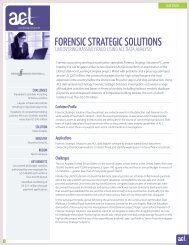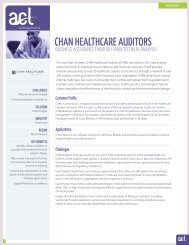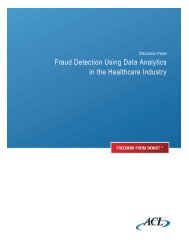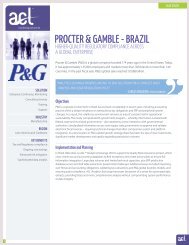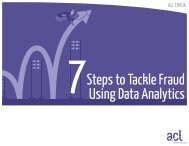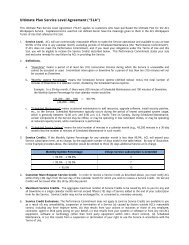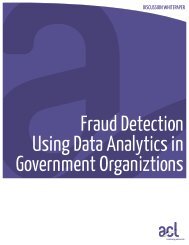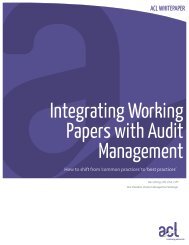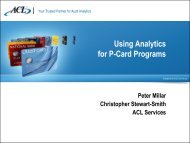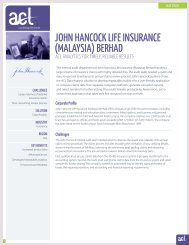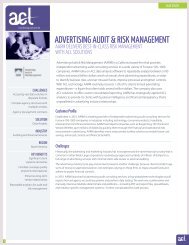Health Check - Acl.com
Health Check - Acl.com
Health Check - Acl.com
Create successful ePaper yourself
Turn your PDF publications into a flip-book with our unique Google optimized e-Paper software.
NEW PERSPECTIVES<br />
on <strong>Health</strong>care Risk Management, Control and Governance<br />
www.AHIA.org Journal of the Association of Heathcare Internal Auditors Vol. 31, No. 3, Fall, 2012<br />
2012<br />
<strong>Health</strong>care Internal<br />
Auditing Survey<br />
page 7<br />
Carrot or Stick:<br />
The Case for Ethics in Compliance and Internal Audit<br />
page 26<br />
<strong>Health</strong> <strong>Check</strong>:<br />
How Purpose-Built Technology Improves Control Assurance<br />
page 32<br />
Charge Capture Audits for Non-Coders:<br />
Real-Value Audits You Can Do<br />
page 61<br />
Keep Them Separate:<br />
Use Automation to Ensure Segregation of Duties<br />
page 49
Feature<br />
<strong>Health</strong> <strong>Check</strong>: How Purpose-Built Technology<br />
Improves Control Assurance<br />
Learn how one audit department powers itself with analytic technology<br />
By Christy Decker, CPA, CIA, CFE; and Kristin Freitas, CPA, CIA, ACDA<br />
Executive Summary<br />
The changes that have moved internal audit to the forefront of organizations also<br />
call for increased and timely productivity in an increasingly <strong>com</strong>plex environment.<br />
Technology exists today that supports the changing demands on healthcare internal<br />
audit functions.<br />
More departments are developing the skill sets and audit applications to embrace<br />
new opportunities. Purpose-built technology can significantly improve analysis<br />
of data files in billing, coding, accounting and <strong>com</strong>pliance. Audit departments can<br />
provide value and added assurance for their organizations by being proactive in<br />
using technology in approaching their responsibilities.<br />
Today’s healthcare industry presents<br />
a variety of unique challenges for<br />
internal audit functions. Federal, state<br />
and corporate regulations have be<strong>com</strong>e<br />
increasingly <strong>com</strong>plex, while technical<br />
demands have continued to grow. Some<br />
of the most challenging requirements<br />
relate to revenue, coding and <strong>com</strong>pliance.<br />
These <strong>com</strong>plexities present opportunities<br />
for auditors to identify data exceptions<br />
to help management improve policy,<br />
regulatory <strong>com</strong>pliance and revenue.<br />
Sharp <strong>Health</strong>Care, a San Diego-based<br />
nonprofit integrated regional healthcare<br />
organization, has four acute-care<br />
hospitals, three specialty hospitals, two<br />
affiliated medical groups, a health plan,<br />
and a full spectrum of other facilities and<br />
services. The internal audit department<br />
is staffed with seven full-time employees<br />
who use audit analytics to extract and<br />
investigate large volumes of data for our<br />
organization.<br />
One of our biggest challenges is to ensure<br />
employees <strong>com</strong>pletely and accurately<br />
capture and process clinical charges<br />
from the point of care to the end of the<br />
billing cycle. It is a challenge that is<br />
nearly impossible without automated<br />
data analysis. Eight years ago, we<br />
implemented audit software from ACL<br />
Services, and we continue to expand how<br />
and where data analytics are applied.<br />
New regulations, new demands<br />
on audit<br />
Looming on the horizon is the<br />
requirement that healthcare providers<br />
convert from International Classification<br />
of Diseases ICD-9 CM to ICD-10<br />
CM diagnosis and procedure codes<br />
to document and bill patient care<br />
procedures. The change, mandated<br />
by the U.S. Department of <strong>Health</strong> and<br />
Human Services, increases the number<br />
of active diagnostic and procedure codes<br />
from approximately 18,000 to more than<br />
140,000.<br />
Our organization<br />
will have to<br />
upgrade more than<br />
60 internal systems.<br />
In preparing for the change, technical<br />
platforms will need to be upgraded. Our<br />
organization will have to upgrade more<br />
than 60 internal systems. It is critical to<br />
the success of this mandated change that<br />
each system is properly programmed.<br />
With audit analytics, we can match and<br />
<strong>com</strong>pare key data files to find anomalies,<br />
incorrect formats and system breakdowns.<br />
The analytics act as an automated sleuth,<br />
hunting down system updates and<br />
interface issues, and providing validation<br />
that the newly implemented diagnostic<br />
and procedure coding will produce<br />
<strong>com</strong>plete, accurate and reliable data.<br />
As part of the up<strong>com</strong>ing testing phase of<br />
the ICD-10 CM implementation, we will<br />
provide real-time assurance that internal<br />
controls, procedures, data conversions<br />
and interface issues are identified and<br />
addressed before going live. We plan to<br />
achieve this by using ACL to match and<br />
validate 100 percent of the new codes and<br />
charges within the various clinical and<br />
billing systems.<br />
Strategic and innovative audit<br />
applications<br />
While audit analytics are excellent for<br />
ad-hoc projects (such as the ICD-10 CM<br />
implementation), our audit team has<br />
achieved some of its best results using<br />
ongoing audits that run on a monthly and<br />
quarterly basis.<br />
Quarterly tests<br />
We began by implementing 12 standardized<br />
analytics that monitor accounts<br />
payable (AP) data for duplicate paid<br />
invoices, vendors missing tax ID<br />
numbers, improper vendor files and<br />
other anomalies. The quarterly tests have<br />
identified nearly $16,000 in duplicate<br />
payments in a year and highlighted<br />
errors in the vendor master file. The<br />
ongoing tests have been so effective that<br />
an AP recovery firm tasked with testing<br />
32 New Perspectives Association of <strong>Health</strong>care Internal Auditors Fall 2012
our organization’s AP files for duplicate<br />
payments has found just one error since<br />
the analytics were launched.<br />
We also work with the <strong>com</strong>pliance<br />
department to perform a quarterly test<br />
to <strong>com</strong>pare our vendors and physicians<br />
to the Office of Inspector General’s List<br />
of Excluded Individuals and Entities and<br />
the General Services Administration’s<br />
Excluded Parties List System.<br />
While this project has not yielded<br />
significant exceptions to date, the tests<br />
highlight our strong environment<br />
of control. They also enable upper<br />
management to spread the word that<br />
<strong>com</strong>pliance data is regularly monitored<br />
and any fraudulent or inappropriate<br />
activity will quickly be detected. This<br />
work used to be outsourced, and that now<br />
represents an annual savings of at least<br />
$12,000 for our organization.<br />
Patient refund testing is performed<br />
quarterly. The analytics identify duplicate<br />
or potentially inappropriate refunds,<br />
such as payments made to an employee’s<br />
address. No inappropriate refund<br />
payments have been identified to date,<br />
but financial services employees are<br />
aware that the patient refund process is<br />
regularly monitored and inappropriate<br />
activity would quickly be detected.<br />
Monthly tests<br />
Another set of analytics targets the<br />
surgical and catheterization lab<br />
departments’ implantable devices. Each<br />
month, the automated analytics system<br />
downloads implantable device charges<br />
based on procedure codes. The analytics<br />
then match and <strong>com</strong>pare the data to find<br />
inaccurate or missed service charges.<br />
For example, our tests recently revealed<br />
two accounts that were charged for total<br />
hip replacements, but the patients actually<br />
received knee implants. In one year, the<br />
analytics have highlighted approximately<br />
$1 million in billing errors, including both<br />
under- and over-charges.<br />
Analytic technology<br />
has made<br />
our team less reliant<br />
on assistance from<br />
Information Systems.<br />
While the financial implications of coding<br />
errors are significant, the analyses can also<br />
be used to enhance employee knowledge.<br />
A patient charge may be accurate, for<br />
example, but the coding may be inaccurate.<br />
Sharing <strong>com</strong>mon errors with coders and<br />
the health information management<br />
team can improve coding procedures and<br />
identify problem areas quickly.<br />
Running the implantable device analysis<br />
on a monthly basis also ensures our<br />
organization receives full patient<br />
reimbursements. Implants and devices are<br />
usually considered “carve-out” charges,<br />
meaning a percentage-based fee for the<br />
implant service is carved out of a patient’s<br />
daily care rate.<br />
Most payers (insurance <strong>com</strong>panies and<br />
HMOs) require timely submission of<br />
claims, so late charges found long after<br />
the procedure was performed might be<br />
impossible to collect. Regular analyses<br />
of patient charge data quickly pinpoint<br />
errors and provide a significant boost to<br />
the bottom line.<br />
Audits of Pyxis and pharmacy charges<br />
We recently launched a pilot project to<br />
identify missed or diverted charges on<br />
two specific drugs dispensed at two of<br />
our hospitals.<br />
When a nurse dispenses these drugs,<br />
the Pyxis MedStations (an automated<br />
medication dispensing system)<br />
electronically records the withdrawal, the<br />
intended patient’s name and the date/<br />
time the drug was dispensed. Using audit<br />
analytics, we easily pull Pyxis records<br />
for <strong>com</strong>parison with Cerner Millennium<br />
system data. Cerner manages and<br />
integrates our Electronic Medical Records<br />
(EMRs) and <strong>com</strong>puterized physician<br />
order entry. Any data anomalies identified<br />
can be flagged for further investigation.<br />
The recent Cerner implementation<br />
has also changed our organization’s<br />
pharmacy billing from charge-ondispensing<br />
to charge-on-administration.<br />
In the past, drugs dispensed from the<br />
Pyxis MedStation would automatically<br />
be charged to the intended patient.<br />
Now, staff must dispense the drug,<br />
administer the medication and document<br />
the treatment in the Cerner system that<br />
generates the patient charge.<br />
We realized that units using the EMR<br />
system often missed charges due to<br />
improper documentation and staff<br />
confusion. By automatically <strong>com</strong>paring<br />
the Pyxis and Cerner data, we can<br />
highlight key process and chargecapture<br />
issues for the nursing and<br />
pharmacy teams.<br />
Lessons learned and best practices<br />
Targeted analytics have equipped<br />
our audit team to achieve a highlevel<br />
perspective on patient trends, to<br />
<strong>com</strong>bine data from different sources and<br />
to drill down into individual records<br />
for further analysis. The solution has<br />
shortened project <strong>com</strong>pletion times and<br />
enhanced productivity, while promoting<br />
greater confidence in the accuracy and<br />
<strong>com</strong>pleteness of our audits.<br />
Analytic technology has made our team<br />
less reliant on assistance from Information<br />
Systems (IS), but we could not have<br />
succeeded without strong ties to that<br />
department. Collaborating with IS has<br />
Fall 2012 Association of <strong>Health</strong>care Internal Auditors New Perspectives 33
Questions answered<br />
• How do you ensure the integrity of the data you are using?<br />
We have direct access to our Lawson financial data (virtual tables on an Oracle<br />
platform that are updated real time) via an ODBC connection to ACL. Our<br />
billing/patient financial information <strong>com</strong>es from a data warehouse. We<br />
typically verify revenue from a sample of days back to the source system (GE-<br />
HPA).<br />
• Once you get potential exceptions, how do you follow up to ensure they are actual<br />
exceptions?<br />
We work very closely with the departments that receive the exceptions. We<br />
verify a sample of the exceptions prior to sending them to the departments. If<br />
the departments note false positives, we work to improve our scripts so we<br />
can reduce the number of false positives sent out with our results.<br />
• How do you follow through to ensure the actual exceptions are addressed?<br />
We require responses from the departments addressing all of the exceptions.<br />
For charge corrections, we verify the corrections were entered into the<br />
billing system.<br />
• Is the access to data tables view access only?<br />
Yes.<br />
• How did you get IS to give you access to the tables (sometimes this is a struggle)?<br />
We have access to a data warehouse with all patient financial/billing<br />
information. We have a good relationship with our IS department. We worked<br />
with them to get direct access to our Lawson financial data (via virtual tables<br />
on an Oracle platform that are updated real time). We collaborate with them<br />
to ensure they understand the objectives of our access requests so they will be<br />
more willing to give us access (view/read only).<br />
• How will you address regulatory changes (e.g., with charging) that impact the data<br />
you analyze?<br />
We plan to use ACL to help test the conversion from ICD-9 CM to ICD-10<br />
CM. We will have to update some of our current scripts and tables after the<br />
conversion.<br />
given us direct, independent access to<br />
data tables and a precise way to query the<br />
organization’s data warehouse.<br />
Having an analytics expert on the internal<br />
audit team has also been extremely<br />
beneficial. All staff members are proficient<br />
in the technology, but it is valuable to<br />
have a technician who can write scripts<br />
and perform the more <strong>com</strong>plex analyses.<br />
When we hit a snag, ACL also has a topnotch<br />
Help Desk that can immediately<br />
assess the problem and answer questions<br />
quickly. The Help Desk is an invaluable<br />
resource for us.<br />
Our audit team has worked hard to build<br />
trust with business units. Many divisions<br />
are eager to collaborate and implement<br />
new analytics. We meet regularly<br />
with these departments to ensure<br />
data analysis projects are beneficial<br />
and the reports are meaningful. Our<br />
organization’s senior management<br />
and the Board Audit and Compliance<br />
Committee have also been supportive of<br />
our work with audit analytics. Regular<br />
reporting ensures open <strong>com</strong>munication<br />
and makes management accountable for<br />
remediating exceptions.<br />
A look to the future<br />
Automated data analysis has been<br />
a powerful way for our audit team<br />
to provide control assurance, while<br />
quickly identifying errors that point<br />
to procedural breakdowns, technical<br />
issues and potentially fraudulent<br />
activities. A flexible solution makes<br />
it easy to access and analyze data<br />
from disparate platforms without<br />
<strong>com</strong>promising data integrity.<br />
<strong>Health</strong>care is an industry marked by<br />
rapid change and increasing <strong>com</strong>plexity.<br />
Auditing 100 percent of transactions<br />
is now imperative for busy audit<br />
departments—and success demands<br />
an organized, repeatable approach to<br />
detecting exceptions and understanding<br />
the significance of those exceptions.<br />
We have taken a proactive approach to<br />
our audit responsibilities. Data analytics<br />
save time, reduce internal costs and<br />
shorten audit cycles. Most importantly,<br />
using purpose-built audit technology<br />
gives us more independence from the<br />
underlying operational and financial<br />
systems. We will continue to identify<br />
new financial, clinical and <strong>com</strong>pliance<br />
areas that will benefit from ongoing data<br />
analysis. NP<br />
Authors<br />
Christy Decker, CPA, CIA, CFE, is the Director of<br />
Internal Audit Services for Sharp <strong>Health</strong>Care in<br />
San Diego, Calif. Prior to joining Sharp <strong>Health</strong>Care<br />
in 2005, she had six years of corporate and public<br />
accounting experience. Christy currently serves as<br />
the District #4 Representative for the West Region<br />
of The Institute of Internal Auditors (IIA) and is a<br />
Board Member of the San Diego IIA Chapter. You<br />
can reach Christy at (858) 499-5508 and by email<br />
at Christy.Decker@sharp.<strong>com</strong>.<br />
Kristin Freitas, CPA, CIA, ACDA, is the<br />
Senior Auditor – Analytics Specialist for Sharp<br />
<strong>Health</strong>Care in San Diego, Calif. She is currently<br />
a Vice President of the San Diego Chapter of The<br />
Institute of Internal Auditors Chapter. You can<br />
reach Kristin at (858) 499-5343 and by email at<br />
Kristin.Freitas@sharp.<strong>com</strong>.<br />
34 New Perspectives Association of <strong>Health</strong>care Internal Auditors Fall 2012



